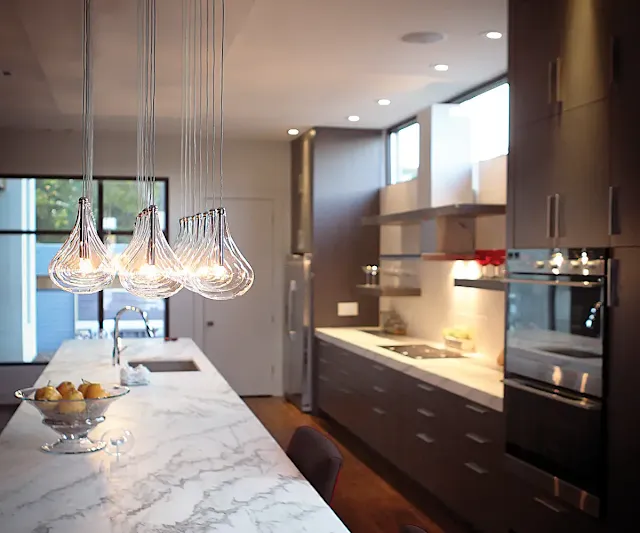Master Architectural Lighting Principles & Case Studies
Master Architectural Lighting Principles & Case Studies
Break down the fundamental principles that guide effective lighting design.
1. Balance:
Achieving equilibrium in lighting distribution is paramount. Balance entails harmonizing light intensity, color temperature, and distribution across a space to avoid visual discomfort or distraction. It involves a judicious interplay between ambient, task, and accent lighting to create a cohesive environment where every element feels in place.
2. Contrast:
Contrast adds depth and visual interest to a space. By juxtaposing areas of differing luminance levels, contrast draws attention to focal points, enhances architectural features, and facilitates wayfinding. Careful consideration of contrast ensures optimal visibility while evoking a sense of drama or subtlety, depending on design intent.
3. Focal Points:
Focal points serve as anchors, directing attention and imbuing spaces with purpose. Effective lighting design highlights these focal points, whether architectural elements, artworks, or functional areas, through strategic placement and intensity modulation. By accentuating focal points, designers shape the narrative and user experience within a space.
4. Layering:
Layering involves the orchestration of multiple lighting sources to create depth, dimension, and visual interest. By combining ambient, task, and accent lighting, designers craft dynamic compositions that cater to various activities and moods. Layering fosters versatility, allowing users to tailor lighting schemes to suit different needs and occasions.
Each principle serves as a building block, guiding designers in crafting compelling lighting narratives that transcend mere functionality. Through a nuanced understanding of balance, contrast, focal points, and layering, designers wield light as a transformative tool, shaping perceptions and enhancing the built environment.
In the subsequent articles, we'll delve deeper into each principle, exploring practical applications, case studies, and design strategies to illuminate the path towards mastery in architectural lighting design. Stay tuned as we unravel the intricacies of light and shadow, unveiling the secrets behind truly captivating illumination.
Cover topics such as balance, contrast, focal points, and layering.
To create balance, designers must consider both the visual and functional aspects of lighting. Visual balance entails distributing light sources symmetrically or asymmetrically to complement the space's architecture and decor. Functional balance ensures that lighting adequately illuminates all areas for their intended purposes, whether it's ambient lighting for general visibility or task lighting for specific activities.
Contrast, while essential for visual interest, should be balanced to prevent stark disparities in brightness that can cause discomfort or visual fatigue. By strategically varying light levels, designers can accentuate focal points and architectural features while maintaining overall harmony.
Harnessing Contrast for Impactful Architectural Lighting
Achieving effective contrast involves carefully controlling the interplay between light and dark elements within a space. This can be accomplished through the strategic placement of light fixtures to highlight architectural features, artworks, or focal points. Additionally, varying light intensity and color temperature can further accentuate contrasts, adding depth and dimension to the environment.
However, excessive contrast should be avoided as it can lead to visual discomfort or distraction. Designers must strike a balance between light and shadow, ensuring that contrast enhances the overall aesthetic without overwhelming the viewer.
Creating Compelling Focal Points with Architectural Lighting
To create compelling focal points, designers must first identify key elements within the space that deserve emphasis. This could include architectural details such as columns, arches, or textures, as well as decorative elements like sculptures or signage.
Once identified, focal points can be accentuated through various lighting techniques, such as spotlighting, grazing, or wall washing. By strategically directing light towards these elements, designers can draw attention to their unique characteristics and create focal points that command the viewer's gaze.
Layering Light for Depth and Dimension in Architectural Design
The three primary layers of light include ambient, task, and accent lighting. Ambient lighting provides overall illumination, establishing the space's general brightness level and ensuring visual comfort. Task lighting serves specific functional purposes, such as reading or food preparation, by providing focused illumination where needed. Accent lighting adds drama and highlights architectural features, artworks, or focal points, creating visual focal points and enhancing the space's aesthetic appeal.
By carefully layering these types of lighting, designers can create versatile environments that accommodate various activities and moods. Additionally, layering allows for flexibility, enabling users to adjust lighting levels according to their preferences and needs.
Provide examples and case studies to illustrate each principle in action.
In the realm of architectural lighting design, principles serve as the cornerstone for achieving visual harmony, functionality, and ambiance within a space. However, grasping these principles in theory is one thing; witnessing their application in real-world scenarios is another. Through a series of meticulously selected case studies, we delve deep into examples that vividly illustrate the effective implementation of fundamental lighting design principles.
Balance in Retail Spaces
In the bustling world of retail, achieving balance through lighting is paramount to creating an inviting and comfortable environment for shoppers. Take, for instance, the case of a high-end boutique aiming to strike the perfect equilibrium between accentuating products and providing a welcoming atmosphere. Here, a combination of focused spotlights and ambient lighting techniques is employed. Spotlights are strategically positioned to highlight key merchandise, while ambient lighting softly illuminates the surrounding space, preventing harsh contrasts and ensuring a cohesive visual experience for customers.
Contrast Techniques in Art Galleries
Art galleries stand as sanctuaries where the interplay of light and shadow accentuates the beauty and depth of displayed artworks. In a renowned gallery showcasing contemporary art, contrast techniques reign supreme in elevating the viewer's engagement with each masterpiece. Picture a minimalist sculpture bathed in a pool of warm, directional light against a backdrop of dimly lit walls. This deliberate contrast not only draws attention to the artwork but also adds a sense of drama and intrigue, compelling visitors to explore further.
Focal Points in Hospitality Settings
Within the realm of hospitality design, creating captivating focal points through lighting is instrumental in shaping the guest experience. Consider a luxurious hotel lobby exuding opulence and grandeur. Here, a cascading chandelier serves as the focal point, commanding attention upon entry. Surrounding ambient lighting gently guides guests towards reception areas and seating zones, while subtle uplighting accentuates architectural features, such as towering columns and ornate moldings, further enhancing the overall ambience of sophistication and allure.
Layering Techniques in Residential Architecture
In residential architecture, the art of layering lighting sources adds depth and versatility to living spaces, catering to various activities and moods. Imagine a contemporary living room designed for relaxation and entertainment. Here, a combination of overhead fixtures, task lighting, and decorative lamps seamlessly coalesce to offer flexibility and ambiance. Recessed ceiling lights provide general illumination, while adjustable floor lamps and sconces offer task lighting for reading or socializing. Meanwhile, accent lighting highlights artwork and architectural details, infusing the space with personality and charm.
Conclusion:
Through these meticulously curated case studies, we witness firsthand how the application of lighting design principles transforms spaces into immersive environments that captivate the senses and elevate the human experience. By embracing balance, contrast, focal points, and layering techniques, designers unlock the full potential of light as a dynamic medium for shaping our interactions with the built environment.





